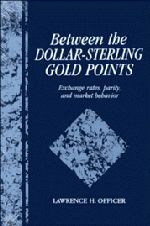Book contents
- Frontmatter
- Contents
- List of figures
- List of tables
- Preface
- List of symbols
- 1 Introduction
- Part I Monetary standards
- 2 The various monetary standards
- 3 American monetary standard
- 4 British monetary standard
- Part II Exchange rate
- Part III Gold points
- Part IV External and internal integration
- Part V Market efficiency
- Part VI Regime efficiency
- Part VII Conclusions
- Notes
- References
- Index
2 - The various monetary standards
Published online by Cambridge University Press: 13 October 2009
- Frontmatter
- Contents
- List of figures
- List of tables
- Preface
- List of symbols
- 1 Introduction
- Part I Monetary standards
- 2 The various monetary standards
- 3 American monetary standard
- 4 British monetary standard
- Part II Exchange rate
- Part III Gold points
- Part IV External and internal integration
- Part V Market efficiency
- Part VI Regime efficiency
- Part VII Conclusions
- Notes
- References
- Index
Summary
Types of monetary standards, and exchange-rate consequences
Any given period in Anglo-American economic history can be characterized by the quintuplet (1) domestic monetary standard in Britain, (2) domestic monetary standard in the United States, (3) international monetary standard in Britain, (4) international monetary standard in the United States, and (5) exchange-rate system involving the two countries' currencies.
The domestic monetary standards that have entered American or British economic history are basically distinguished as metallic versus paper standards, where a metallic standard is founded on metallic money and a paper standard on paper currency. Metallic standards are either monometallic, subdivided into gold or silver standards, or bimetallic, meaning that both a gold and a silver standard are involved. A domestic metallic standard is called a specie standard, because it is based on coined money, an archaic word for which is “specie.”
The corresponding international monetary standards for a given country are also divided into metallic or paper standards. A metallic standard, in addition to the gold, silver, or bimetallic breakdown, can be divided into a specie standard, as above, or a bullion standard, meaning a foundation on bars rather than coin.
The domestic and international monetary standards as just defined are country-specific dependent. The exchange-rate system between two countries is a joint characteristic of the international monetary standards of the countries involved and is also a function of the exchange-market intervention policies of the countries' authorities.
- Type
- Chapter
- Information
- Between the Dollar-Sterling Gold PointsExchange Rates, Parity and Market Behavior, pp. 7 - 10Publisher: Cambridge University PressPrint publication year: 1996



